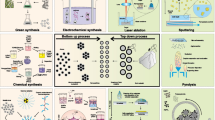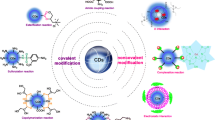Abstract
Due to the unique chemical and biomedical properties of carbon dots (CDs), they have increasingly obtained the attention in many research fields, for example, bioimaging, fluorescence sensing, and drug delivery, etc. Recently, it was found that, under light excitation, CDs can also be exploited as a novel photosensitizer to prepare reactive oxygen species (ROS), which expand their applications in the field of photodynamic therapy for cancer treatment. Nevertheless, the high cost and complex fabrication approach of CDs significantly limit their applications. To address this issue, bottom-up routes usually utilize sustainable and inexpensive carbon precursor as starting materials, employed N,N-dimethylformamide (DMF) or ethanol as an environmental-friendly solvent. Bottom-up approach was energy efficient, and the purification process was relatively simple by dialysis. Therefore, carbon dots (CDs) were facilely fabricated in a one-pot solvothermal process using 1-aminoanthraquinone as a precursor, and their application as photosensitizers for in vitro antitumor cells, especially photodynamic therapy (PDT) was established. Then the photophysical and nanoscale dimensions properties of the fabricated CDs were characterized via TEM, UV–visible, fluorescence, and FT-IR spectroscopy. The synthesized N-doped CDs can easily dissolve in water, possess very low biotoxicity, yellow-light emission (maximum peak at 587 nm). More importantly, PDT studies demonstrated that the obtained CDs possess a high singlet oxygen yield of 35%, and exhibit significant phototoxicity to cancer cells upon 635 nm laser irradiation. These studies highlight that N-doped CDs can be facilely synthesized from only one precursor, and are a potentially novel theranostic agent for in vivo PDT.






Similar content being viewed by others
Data Availability
No datasets were generated or analyzed during the current study.
References
Bray F, Laversanne M, Weiderpass E, Soerjomataram I (2021) The ever-increasing importance of cancer as a leading cause of premature death worldwide. Cancer 127:3029–3030
Sung H, Ferlay J, Siegel RL, Laversanne M, Soerjomataram I, Jemal A, Bray F (2021) Global cancer statistics 2020: globocan estimates of incidence and mortality worldwide for 36 cancers in 185 countries. CA Cancer J Clin 71:209–249
De La Puente P, Azab AK (2017) Nanoparticle delivery systems, general approaches, and their implementation in multiple myeloma. Eur J Haematol 98:529–541
Karagianni A, Tsierkezos NG, Prato M, Terrones M, Kordatos KV (2022) Application of carbon-based quantum dots in photodynamic therapy. Carbon 203:273–310
Gunaydin G, Gedik ME, Ayan S (2021) Photodynamic therapy-current limitations and novel approaches. Front Chem 9:691697
Ding H, Zhou XX, WeiS LXB, Qin BT, Chen XB, Xiong HM (2020) Carbon dots with red/near-infrared emissions and their intrinsic merits for biomedical applications. Carbon 167:322–344
Akbar A, Khan S, Chatterjee T, Ghosh M (2023) Unleashing the power of porphyrin photosensitizers: illuminating breakthroughs in photodynamic therapy. J Photochem Photobiol B 248:112796
Son J, Yi G, Kwak MH, Yang SM, Park JM, Lee BI, Choi MG, Koo H (2019) Gelatin-chlorin e6 conjugate for in vivo photodynamic therapy. NanoBiotechnology 17(1):50
Juneja R, Lyles Z, Vadarevu H, Afonin KA, Vivero-Escoto JL (2019) Multimodal polysilsesquioxane nanoparticles for combinatorial therapy and gene delivery in triple-negative breast cancer. ACS Appl Mater Interfaces 11:12308–12320
Chariou PL, Wang L, Desai C, Park J, Robbins LK, von Recum HA, Ghiladi RA, Steinmetz NF (2019) Let there be light: Targeted photodynamic therapy using high aspect ratio plant viral nanoparticles. Macromol Biosci 19(5):e1800407
Masarapu H, Patel BK, Chariou PL, Hu H, Gulati NM, Carpenter BL, Ghiladi RA, Shukla S, Steinmetz NF (2017) Physalis mottle virus-like particles as nanocarriers for imaging reagents and drugs. Biomacromol 18:4141–4153
Huang L, Wang M, Huang YY, El-Hussein A, Wolf LM, Chiang LY, Hamblin MR (2018) Progressive cationic functionalization of chlorin derivatives for antimicrobial photodynamic inactivation and related vancomycin conjugates. Photochem Photobiol Sci 17:638–651
Rajora MA, Lou JWH, Zheng G (2017) Advancing porphyrin’s biomedical utility via supramolecular chemistry. Chem Soc Rev 46:6433–6469
Hurst AN, Scarbrough B, Saleh R, Hovey J, Ari F, Goyal S, Chi RJ, Troutman JM, Vivero-Escoto JL (2019) Influence of cationic meso-substituted porphyrins on the antimicrobial photodynamic efficacy and cell membrane interaction in Escherichia coli. Int J Mol Sci 20(1):134
Le Guern F, Sol V, Ouk C, Arnoux P, Frochot C, Ouk TS (2017) Enhanced photobactericidal and targeting properties of a cationic porphyrin following the attachment of polymyxin B. Bioconjug Chem 28:2493–2506
Wallat JD, Wek KS, Chariou PL, Carpenter BL, Ghiladi RA, Steinmetz NF, Pokorski JK (2017) Fluorinated polymer–photosensitizer conjugates enable improved generation of ROS for anticancer photodynamic therapy. Polym Chem 8:3195–3202
Wolfbeis OS (2015) An overview of nanoparticles commonly used in fluorescent bioimaging. Chem Soc Rev 44:4743–4768
Chen Z, Liu Y, Kang Z (2022) Diversity and tailorability of photoelectrochemical properties of carbon dots. Acc Chem Res 55(21):3110–3124
Barrientos K, Arango JP, Moncada MS, Placido J, Patiño J, Macías SL, Maldonado C, Torijano S, Bustamante S, Londoño ME, Jaramillo M (2023) Carbon dot-based biosensors for the detection of communicable and non-communicable diseases. Talanta 251:123791
Yadav S, Choudhary N, Sonpal V, Paital AR (2023) Engineering excitation-independent turn-on fluorescent probe for mercury: Functionalized dendritic silica doped with red-emissive carbon dots towards simultaneous detection and remediation with biosensing application. Chem Eng J 471:144715
Hussain MM, Khan WU, Ahmed F, Wei Y, Xiong H (2023) Recent developments of Red/NIR carbon dots in biosensing, bioimaging, and tumor theranostics. Chem Eng J 465:143010
Liu C, Fan W, Cheng WX, Gu Y, Chen Y, Zhou W, Yu XF, Chen M, Zhu M, Fan K, Luo Q (2023) Red emissive carbon dot superoxide dismutase nanozyme for bioimaging and ameliorating acute lung injury. Adv Func Mater 33(19):2213856
Bartkowski M, Zhou Y, Nabil Amin Mustafa M, Eustace AJ, Giordani S (2024) CARBON DOTS: Bioimaging and anticancer drug delivery. Chem Eur J 30(19):e202303982
Zhang W, Chen J, Gu J, Bartoli M, Domena JB, Zhou Y, Ferreira BC, Cilingir EK, McGee CM, Sampson R, Arduino C (2023) Nano-carrier for gene delivery and bioimaging based on pentaetheylenehexamine modified carbon dots. J Colloid Interface Sci 639:180–192
Wang B, Lu S (2022) The light of carbon dots: From mechanism to applications. Matter 5(1,5):110–149
Fan HY, Yu XH, Wang K, Yin YJ, Tang YJ, Tang YL, Liang XH (2019) Graphene quantum dots (GQDs)-based nanomaterials for improving photodynamic therapy in cancer treatment. Eur J Med Chem 182:111620
Lu D, Tao R, Wang Z (2019) Carbon-based materials for photodynamic therapy: a mini-review. Front Chem Sci Eng 13:310–323
Li Z, Pei Q, Zheng YH, Xie ZG, Zheng M (2023) Carbon dots for long-term near-infrared afterglow imaging and photodynamic therapy. Chem Eng J 467:143384
Song J, Gao X, Yang M, Hao W, Ji DK (2023) Recent advances of photoactive near-infrared carbon dots in cancer photodynamic therapy. Pharmaceutics 15(3):760
Luo T, Yang H, Wang R, Pu Y, Cai Z, Zhao Y, Bi Q, Lu J, Jin R, Nie Y, Shuai X (2023) Bifunctional cascading nanozymes based on carbon dots promotes photodynamic therapy by regulating hypoxia and glycolysis. ACS Nano 17(17):16715–16730
Li B, Zhao S, Huang L, Wang Q, Xiao J, Lan M (2021) Recent advances and prospects of carbon dots in phototherapy. Chem Eng J 408:127245
Mandal S, Prasad SR, Mandal D, Das P (2019) BSA amplified ROS generation from Anthrarufin derived Carbon dot and concomitant Nanoassembly for combination antibiotic-photodynamic therapy application. ACS Appl Mater Interfaces 11(36):33273–33284
Jia Q, Ge J, Liu W, Zheng X, Chen S, Wen Y, Zhang H, Wang P (2018) A magnetofluorescent carbon dot assembly as an acidic H2 O2 -driven oxygenerator to regulate tumor hypoxia for simultaneous bimodal imaging and enhanced photodynamic therapy. Adv Mater 30(13):e1706090
Nie X, Jiang C, Wu S, Chen W, Lv P, Wang Q, Liu J, Narh C, Cao X, Ghiladi RA, Wei Q (2020) Carbon quantum dots: a bright future as photosensitizers for in vitro antibacterial photodynamic inactivation. J Photochem Photobiol B 206:111864
Li L, Zhang R, Lu C, Sun J, Wang L, Qu B, Li T, Liu Y, Li S (2017) In situ synthesis of NIR-light emitting carbon dots derived from spinach for bio-imaging applications. Jf Mater Chem B 5(35):7328–7334
Wang Y, Lao S, Ding W, Zhang Z, Liu S (2019) A novel ratiometric fluorescent probe for detection of iron ions and zinc ions based on dual-emission carbon dots. Sens Actuators B Chem 284:186–192
Yang Y, Ding H, Li Z, Tedesco AC, Bi H (2022) Carbon dots derived from tea polyphenols as photosensitizers for photodynamic therapy. Molecules 27(23):8627
Zhao S, Yang K, Jiang L, Xiao J, Wang B, Zeng L, Song X, Lan M (2021) Polythiophene-based carbon dots for imaging-guided photodynamic therapy. ACS Appl Nano Mater 4(10):10528–10533
Xu N, Du J, Yao Q, Ge H, Li H, Xu F, Gao F, Xian L, Fan J, Peng X (2020) Precise photodynamic therapy: penetrating the nuclear envelope with photosensitive carbon dots. Carbon 159:74–82
Wang N, Xu H, Sun S, Guo P, Wang Y, Qian C, Zhong Y, Yang D (2020) Wound therapy via a photo-responsively antibacterial nano-graphene quantum dots conjugate. J Photochem Photobiol B 210:111978
Zhang Y, Jia Q, Nan F, Wang J, Liang K, Li J, Xue X, Ren H, Liu W, Ge J, Wang P (2023) Carbon dots nanophotosensitizers with tunable reactive oxygen species generation for mitochondrion-targeted type I/II photodynamic therapy. Biomaterials 293:121953
Gai S, Yang G, Yang P, He F, Lin J, Jin D, Xing B (2018) Recent advances in functional nanomaterials for light–triggered cancer therapy. Nano Today 19:146–187
Murali G, Kwon B, Kang H, Modigunta JK, Park S, Lee S, Lee H, Park YH, Kim J, Park SY, Kim YJ (2022) Hematoporphyrin photosensitizer-linked carbon quantum dots for photodynamic therapy of cancer cells. ACS Appl Nano Mater 5(3):4376–4385
Funding
This work was supported by 2023 Weifang Medical University Affiliated Hospital Science and Technology Development Project (2023FYZ018), the Key Research & Development Program of Linyi, Shandong Province (2022YX0093) and Qilu Special Project (YXH2022ZX02069).
Author information
Authors and Affiliations
Contributions
Pengli Zuo was responsible for conceptualization, synthesis, data curation, writing-original draft. Jun Peng was responsible for resources, conceptualization. Yuyang Yao: software, formal analysis, investigation, methodology, validation. Wei Tan was responsible for synthesis, funding acquisition, project administration. Lan Cheng: investigation and methodology. Jinyu Zhang: resources and formal analysis. Xiuhua Lu: formal analysis, supervision, writing-review & editing. All authors reviewed the manuscript.
Corresponding author
Ethics declarations
Ethical Approval
Not applicable.
Competing Interests
The authors declare no competing interests.
Additional information
Publisher's Note
Springer Nature remains neutral with regard to jurisdictional claims in published maps and institutional affiliations.
Supplementary Information
Below is the link to the electronic supplementary material.
Rights and permissions
Springer Nature or its licensor (e.g. a society or other partner) holds exclusive rights to this article under a publishing agreement with the author(s) or other rightsholder(s); author self-archiving of the accepted manuscript version of this article is solely governed by the terms of such publishing agreement and applicable law.
About this article
Cite this article
Zuo, P., Peng, J., Yao, Y. et al. Fabrication of Carbon Dots with Singlet Oxygen Generation and Their Potential Photodynamic Therapy Applications. J Fluoresc (2024). https://doi.org/10.1007/s10895-024-03725-6
Received:
Accepted:
Published:
DOI: https://doi.org/10.1007/s10895-024-03725-6




